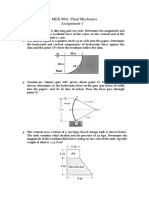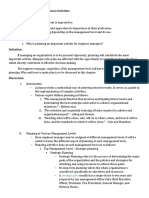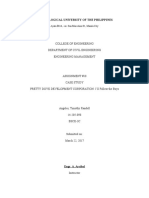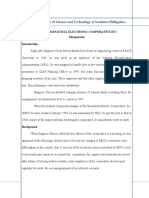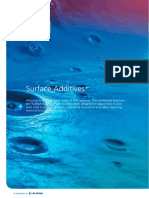Eng'g Management Chapters 3 and 4
Eng'g Management Chapters 3 and 4
Uploaded by
Eddylyn MarieCopyright:
Available Formats
Eng'g Management Chapters 3 and 4
Eng'g Management Chapters 3 and 4
Uploaded by
Eddylyn MarieCopyright
Available Formats
Share this document
Did you find this document useful?
Is this content inappropriate?
Copyright:
Available Formats
Eng'g Management Chapters 3 and 4
Eng'g Management Chapters 3 and 4
Uploaded by
Eddylyn MarieCopyright:
Available Formats
BATANGAS STATE UNIVERSITY College of Engineering, Architecture and Fine Arts Gov.
Pablo Borbon Campus II, Alangilan, Batangas City, Philippines 4200 www.batstate-u.edu.ph Telefax: (043) 300-4044 locs. 106-108
IE 551 Engineering Management
Prepared by: Caraan, Zaila Marie R. Magboo, Princess Joy M. Rendon, Cathryne Joy L. Torrano, Eddylyn Marie C. ChE 5202
November 2013
Chapter 3 PLANNING TECHNICAL ACTIVITIES The Nature of Planning A plan, which is the output of planning, provides a methodical way of achieving desired results. In the implementation of activities, the plan serves as a useful guide. Without the plan, some minor tasks may be afforded major attention which may, later on, hinder the accomplishment of objectives.
Planning Defined Planning according to various experts refers to; the management function that involves anticipating future trends and determining the best strategies and tactics to achieve organizational objective. Nickels and others the selection and sequential ordering of tasks required to achieve an organizational goal. Aldag and Stearns deciding what will be done, who will do it, where, when and how it will be done, and the standards to which it will be done. Cole and Hamilton
For our purpose, it will suffice to define planning as selecting the best course of action so that the desired result may be achieved. Planning at Various Management Levels Planning activities undertaken at various levels are as follows: 1. Top management level strategic planning 2. Middle management level intermediate planning 3. Lower management level operational planning 1. Strategic Planning The term strategic planning refers to the process of determining the major goals of the organization and the policies and strategies for obtaining and using resources to achieve those goals. The top management of any firm is involved in this type of planning. In strategic planning, the whole company is considered, specifically its objectives and current resources. The output of strategic planning is the strategic plan which spells out the decision about long range goals and the course of action to achieve these goals. 2. Intermediate Planning Intermediate planning refers to the process of determining the contributions that subunits can make with allocated resources. This type of planning is undertaken by middle management.
Under intermediate planning, the goals of a subunit are determined and a plan is prepared to provide a guide to the realization of the goals. The intermediate plan is designed to support the strategic plan. 3. Operational Planning The term operational planning refers to the process of dete rmining how specific tasks can best be accomplished on time with available resources. This type of planning is a responsibility of lower management. It must be performed in support of the strategic plan and intermediate plan. The Planning Process Generally, planning involves the following: 1. Setting Organizational, Divisional or Unit Goals The first task of the engineer manager is to provide a sense of direction to his firm, to his division, or to his unit. The setting of goals provides an answer to the said concern. Goals may be defined as the precise statement of result sought, quantified in time and magnitude, where possible. 2. Developing Strategies or Tactics to Reach Goals After determining the goals, the next task is to devise some means to realize them. The ways to realize the goals are called strategies and these will be the concern of top management. The middle and lower management will adapt their own tactics to implement their plans. A strategy may be defined as a course of action aimed at ensu ring that the organization will achieve its objectives. A tactic is a short-term action taken by management to adjust to negative internal or external influences. They are formulated and implemented in support of the firms strategies. The decision about short-term goals and the courses of action are indicated in the tactical plan. 3. Determining Resources Needed When particular set of strategies or tactics have been devised, the engineer manager will, then, determine the human and nonhuman resources required by such strategies or tactics. Even if the resource requirements are currently available, they must be specified. The quality and quantity of resources needed must be correctly determined. Too many resources in terms of either quality or quantity will be wasteful. Too little will mean loss of opportunities for maximizing income. To satisfy strategic requirements, a general statement of needed resources will suffice. The specific requirements will be determined by the different units of the company. 4. Setting Standards
The standards for measuring performance may be set at the planning stage. When actual performance does not match with the planned performance, corrections may be made or reinforcements given. A standard may be defined as a quantitative or qua litative measuring device designed to help monitor the performances of people, capital goods, or processes. An example of a standard is the minimum number of units that must be produced by a worker per day in a given work situation. Fig. 3 Types of Plans
TYPES OF PLANS Plans are of different types. They may be classified in terms of functional areas, time horizon and frequency of use. Functional Areas Plans Plans may be preapared according to the needs of the different functional areas. Among the types of functional area plans are the following: 1. Marketing Plan this is the written document or blueprint for implementing and controlling an organizations marketing activities related to a particular marketing strategy. 2. Production Plan this is written document that states the quantity of output a company must produce in board terms and by product family.
3. Financial Plan it is a document that summarizes the current financial situation of the of the firm,analyzes financial needs and recommends a direction for financial activities. 4. Human resouce management plan it is a document that indicates the human resource needs of a company detailed in terms of quantity and quality and based on the requirements of the companys strategic plan. Plans with Time Horizon 1. Short range Plans these are plans intented to cover a period of less than one year. First-line supervisors are mostly concerned with these plans. 2. Long- range Plans these are plans covering a time span of more than one year. These are mostly undertaken by middle and top management. Plans according to Frequency of Use 1. Standing Plans plans that are used again and again and they focus on managerial situations that recur repeatedly. This is further classified into: a. Policies they are broad guidelines to aid managers at every level in making decisions about recurring situations or function b. Procedures they are plans that describe the exact series of actions to be taken in a given situation c. Rules they are statements that either require or forbid a certain action 2. Single Use Plans Plans that are specifically developed to implement courses of action that are relatively unique and are unlikely to be repeated. Further classified as follows: a. Budgets a plan which sets forth the expenditure for a certain activity and explains where the required funds will come from b. Program designed to coordinate a large set of activities c. Project usually limited in scope than a program that is sometimes prepared to support a program PART OF THE VAROIUS FUNCTIONAL AREA PLANS Contents Of Marketing Plan 1. The Executive Summary presents an overall view of marketing project and its potential 2. Table of Contents 3. Situational Analysis and Target Market 4. Marketing Objectives and Goals 5. Marketing Strategies 6. Marketing Tactics
7. Schedule and Budgets 8. Financial Data and Control
Contents of the Production Plan 1. The amount of capacity of the company must have 2. How many employees are required 3. How much material must be pruchased
Contents of Financial Plan 1. An analysis of the firms current financial condition as indicated by an analysis of the most recent statements 2. A sales forecast 3. The capital budget 4. The cash budget 5. A set of pro forma (or projected) financial statements 6. The external financing plan
Contents Of Human Resource Management plan 1. Personnel requirements of the company
2. Plans for recruitment and selection 3. Training plan 4. Retirement plan
PARTS OF THE STRATEGIC PLAN 1. Company or corporate mission refers to the strategic statement that identifies why an organization exists,its philosophy of management and its purpose as distinguished from other similar oraganizations in terms of products,services and markets 2. Objectives or goals 3. Strategies
MAKING PLANNING EFFECTIVE 1. Recognize the planning barriers Planning barriers according to Plunkett and Attner 1. Managers inability to plan 2. Improper planning process 3. Lack of commitment to the planning process 4. Improper information 5. Focusing on the present at the express of the future 6. Too much reliance on the planning department 7. Concentrating on only the controllable variables 2. Use of Aids in planning 1. Gather as much information as possible 2. Develop multiple sources of information 3. Involve others in the planning process
Chapter 4 Organizing Technical Activities
Reasons for Organizing - to facilitate the implementation of plan - breakdown the total job into more manageable man-size jobs Organizing is a management function which refers to the the structuring of resources and activities to accomplish objectives in an efficient and effective manner.
Structure It is the arrangement or relationship of positions within an organization. Result of organizing process
Purpose of Structure 1. It defines the relationship between task and authority for individuals and departments 2. It defines formal reporting relationships, the number of levels in the hierarchy of the organization, and the span of control 3. It defines the grouping of individuals into departments and departments in the organization. 4. It defines the system to effect coordination of effort in both vertical (authority) and horizontal (tasks) directions.
When structuring an organization, the manager must be concerned with the following: 1. Division of labor determining the scope of work and how it is combined in a job. 2. Delegation of authority the process of assigning various degrees of decision-making authority to subordinates
3. Departmentation the grouping of related job, activities or processes into major organizational subunits. 4. Span of Control the number of people who report directly to a given manager. 5. Coordination the linking of activities in the organization that serves to achieve a common goal or objective.
Formal Organization - the structure that details lines and responsibilities, authority, and position. - planned structure and it represents the deliberate attempt to establish patterned relationships among the components that will meet the objectives effectively.
The formal structure is described by management through: Organizational chart - diagram of the organizations official positions and formal lines of authority Organizational Manual - provides written descriptions of authority relationships, details the functions of major organizational units, and describes job procedures Policy manual -describes personnel activities and company policies
Informal Groups Group with friendship as a principal reason for belonging Vulnerable to expediency, manipulation, and opportunism. It is low visibility, makes it difficult for management to detect these perversions, and considerable harm can be done to the company. ( Valentine, 1982)
Fig 4.1 Reasons or Factors for Joining or Forming a Group
Types of Oganizational Structures 1. Functional Organization form of departmentation in which everyone engaged in one functional activity, such as engineering or marketing, is grouped into one unit. 2. Product or Market Organization refers to the organization of the company by division that bring together all those involved with a certain type of product or customer 3. Matrix Organization- an organizational structure in which each employee reports both a functional or division manager and to a project or group manager.
Functional Organization Organizational structure that uses the principle of specialization based on function or role. Effective in smaller firms, specially single-business firms where key activities revolve around well-defined skills and areas of specialization. Advantages: 1. The groupings of employees who perform a common task permit a economies
of scale and efficient resource use. 2. Since the chain of command converges at the top of the organization, decision-making is centralized. 3. Communication and coordination among employees within each department are excellent. 4. Promotes high-quality technical problem-solving. 5. Provided with in depth skill specialization and development. 6. Employees are provided with career progress within functional departments. Disadvantages: 1. Communication and coordination between the departments are often poor. 2. Decisions that are more than one department pile up at the top management level and are often delayed. 3. Work specialization and division of labor produce routine, no motivating employee tasks. 4. Difficult to identify which group is responsible for certain problems. 5. Limited view of organizational goals by employees. 6. Limited general management training for employees. Product or Market Organization With its feature of operating by divisions, it is appropriate for large corporation with many product lines in several related companies. Advantages: 1. Flexible and responsive to change. 2. Provides high concern for customers needs. 3. Provides excellent coordination across functional departments. 4. Easy pinpointing of responsibility for product problems. 5. Emphasis on overall product and division goals. 6. Development of general management skills is provided. Disadvantages: 1. High possibility of duplication of resources across divisions. 2. Less technical depth and specialization in divisions. 3. Poor coordination across divisions. 4. Less top management control. 5. Competition for corporate resources. Matrix Organization According to Thompson and Strickland, it is a structure with two or more channels of command, two lines of budget authority, and two sources of performance and reward. Higgins declared that the matrix structure was designed to keep employees in a central pool and to allocate them to various projects in the firm according to length of time they were needed. Advantages:
1. More efficient use of resources than the divisional structure. 2. Flexibility and adaptability to changing environment. 3. Development of both general and functional management skills are present. 4. Interdisciplinary cooperation and any expertise are available to all divisions. 5. Enlarged tasks for employees which motivate them better. Disadvantages: 1. Frustration and confusion from dual chain of command. 2. High conflict between divisional and functional interests. 3. Many meetings and more discussion than action. 4. A need for human relations training for key employees and managers. 5. Tendency for power dominance by one side of the matrix. AUTHORITY It is the right to perform or command. It allows its holder to act in certain designated ways and to directly influence the actions of other. TYPES OF AUTHORITY 1. Line Authority a managers right to tell subordinates what to do and then see they do it. 2. Staff Authority a staff specialists right to give advice to superior. 3. Functional Authority a specialists right to oversee lower level personnel Involved in that specialty, regardless of where the personnel are in the organization. Line departments perform tasks that reflect the organizations primary goal and mission. Staff departments include all those that provided specialized skills in support of line departments. Examples: Strategic Planning Accounting Labor Relations Personnel Research Functional Authority is one given to a person or work group to make decisions related to their expertise even if these decisions concern other departments. THE PURPOSE OF COMMITTEES Committee - is a formal group of persons formed for a specific purpose.
The product planning committee, as described by Millevo, is often staffed by top executives from marketing, production, research, engineering, and finance, who work part-time to evaluate and approved product ideas. Classification of Committees: 1. Ad hoc committee one created for a short term purpose and have a limited life. Example: Committee created to manage the anniversary festivities of the firm. 2. Standing committee it is relatively permanent committee that deals with Issues on an ongoing basis. Example: Grievance committee which is set up to handle initially complaints from employees of the organization.
You might also like
- Planning - Engineering ManagementDocument24 pagesPlanning - Engineering ManagementKatherine Shayne Yee67% (3)
- Chapter 3 Planning Technical ActivitiesDocument19 pagesChapter 3 Planning Technical ActivitiesJm GorgonioNo ratings yet
- Chapter 5 Staffing The Engineering OrganizationDocument4 pagesChapter 5 Staffing The Engineering OrganizationJm GorgonioNo ratings yet
- Cases emDocument5 pagesCases emSharmaine MercadoNo ratings yet
- Engineering Management by Roberto MedinaDocument3 pagesEngineering Management by Roberto MedinaLourence Adriel Dimaunahan0% (1)
- Case StudyDocument4 pagesCase StudyDaniela ArguellesNo ratings yet
- Case Study No.8Document4 pagesCase Study No.8Janfel Limbo100% (4)
- Digital Assignment 1Document1 pageDigital Assignment 1Arvind GiridharNo ratings yet
- Phanikumar TransportPhenomenaNotes 01feb2010Document109 pagesPhanikumar TransportPhenomenaNotes 01feb2010aalisafa50% (2)
- Planning Technical ActivitiesDocument31 pagesPlanning Technical ActivitiesRJ BragaNo ratings yet
- Chapter 9Document2 pagesChapter 9Mark Anthony Mores FalogmeNo ratings yet
- A Case Study About The MOTORBUS COMPANY: Que Sera SeraDocument14 pagesA Case Study About The MOTORBUS COMPANY: Que Sera SeraDaille Wroble GrayNo ratings yet
- A Case Study About The MOTORBUS COMPANYDocument8 pagesA Case Study About The MOTORBUS COMPANYDaille Wroble GrayNo ratings yet
- CASE-2 Now or NeverDocument6 pagesCASE-2 Now or NeverJullian Lenard PinedaNo ratings yet
- Kent Lawrence Lordan (Outputs 7&8) PDFDocument10 pagesKent Lawrence Lordan (Outputs 7&8) PDFKent Lawrence Lordan0% (1)
- Engineering Management (Decision Making)Document1 pageEngineering Management (Decision Making)Jedidiah Joy Palma100% (1)
- ES 4 Management and Its FunctionDocument12 pagesES 4 Management and Its FunctionRenesiy Marco NovillaNo ratings yet
- Dianito, Alfred Y. BSME-2Document1 pageDianito, Alfred Y. BSME-2alfred gamingNo ratings yet
- Case 4: Bits and Pieces International Corporation: Little Things Mean A Lot Reaction Paper/Case StudyDocument1 pageCase 4: Bits and Pieces International Corporation: Little Things Mean A Lot Reaction Paper/Case StudyAlcedo Karen R.No ratings yet
- Case Study Assessment 4Document2 pagesCase Study Assessment 4Christian John Resabal BiolNo ratings yet
- Controlling Case StudyDocument3 pagesControlling Case StudyJulius Torres SilvaNo ratings yet
- Planning: Planning at Various Management LevelsDocument5 pagesPlanning: Planning at Various Management LevelsFelsie Jane PenasoNo ratings yet
- Case 7Document2 pagesCase 7GiaFebieDeAsis100% (6)
- Guidelines To Practice Under The Fundamental Canons of EthicsDocument21 pagesGuidelines To Practice Under The Fundamental Canons of EthicsChan Marie Camacho PielagoNo ratings yet
- Chapter 2Document13 pagesChapter 2MarvinNo ratings yet
- Chapter 3 - Engineering ManagementDocument6 pagesChapter 3 - Engineering ManagementJohn Philip Molina NuñezNo ratings yet
- Chapter 9 - ControllingDocument1 pageChapter 9 - ControllingLovekosimartianNo ratings yet
- University of Science and Technology of Southern PhilippinesDocument3 pagesUniversity of Science and Technology of Southern PhilippinesJeanly JalandoniNo ratings yet
- Group 5 - CASE STUDY 2Document3 pagesGroup 5 - CASE STUDY 2Jeanly JalandoniNo ratings yet
- Case 6Document3 pagesCase 6Cristine Sanchez50% (4)
- Module 3-Planning Technical ActivitiesDocument9 pagesModule 3-Planning Technical ActivitiesLegenGaryNo ratings yet
- Case Study 10Document2 pagesCase Study 10jellNo ratings yet
- Assignment #2Document4 pagesAssignment #2beny SahagunNo ratings yet
- University of Science and Technology of Southern PhilippinesDocument3 pagesUniversity of Science and Technology of Southern PhilippinesLayla Miya100% (1)
- Decision Making, Engineering ManagementDocument27 pagesDecision Making, Engineering Managementnep50% (4)
- USD Part 1Document36 pagesUSD Part 1hgfhfghfghgNo ratings yet
- CE 323 - Engineering Management Case Study No. 6: Submitted By: Roger F. Villaruel, JRDocument4 pagesCE 323 - Engineering Management Case Study No. 6: Submitted By: Roger F. Villaruel, JRGEr JrvillaruElNo ratings yet
- CE115 Engineering Management PDFDocument25 pagesCE115 Engineering Management PDFAshuriko Kazu100% (1)
- Precious Antonette M Catchillar's CASE STUDY - Alma ElectronicsDocument5 pagesPrecious Antonette M Catchillar's CASE STUDY - Alma ElectronicsCatchNo ratings yet
- Orca Share Media1441076786084Document3,341 pagesOrca Share Media1441076786084Pauline Silva0% (1)
- Leading Engineering ManagementDocument20 pagesLeading Engineering ManagementEllerie MangayaNo ratings yet
- IsnDocument13 pagesIsnDaniellaMaeXDBienNo ratings yet
- Case AnalysisDocument2 pagesCase AnalysisJessa San PedroNo ratings yet
- For Reference OnlyDocument2 pagesFor Reference OnlyBenmark Jabay100% (1)
- Basic Elements of Transportation PlanningDocument3 pagesBasic Elements of Transportation Planningnouri100% (1)
- Why Are Engineers Considered An Important Segment of The Society?Document2 pagesWhy Are Engineers Considered An Important Segment of The Society?Angellete D. GacayanNo ratings yet
- BAUTISTA, DARLENE JOY C. - 2CE-C - Module 3 Activity 1,2 and 3Document2 pagesBAUTISTA, DARLENE JOY C. - 2CE-C - Module 3 Activity 1,2 and 3DARLENE JOY C. BAUTISTANo ratings yet
- Staffing The Engineering OrganizationDocument2 pagesStaffing The Engineering OrganizationJulius MananghayaNo ratings yet
- 7 Section 3 - JayDocument11 pages7 Section 3 - JayJoshua Ian AbanNo ratings yet
- Cee 109 - First ExamDocument43 pagesCee 109 - First ExamRonald Renon QuiranteNo ratings yet
- Chapter 1-The Field of Engineering ManagementDocument25 pagesChapter 1-The Field of Engineering ManagementMikari Nakahuro100% (1)
- Fundamental Concepts: Engineering Economy 1Document10 pagesFundamental Concepts: Engineering Economy 1Andre BocoNo ratings yet
- Department of Education Schools Division of Zamboanga Del NorteDocument3 pagesDepartment of Education Schools Division of Zamboanga Del Nortearjo17122No ratings yet
- Engineering Management Part 2Document88 pagesEngineering Management Part 2Jeanne Shannon GarciaNo ratings yet
- Ojt ExperienceDocument20 pagesOjt ExperienceAngeline PinonNo ratings yet
- Exercise 2a-Macalinao, Joshua M.Document2 pagesExercise 2a-Macalinao, Joshua M.Joshua MacalinaoNo ratings yet
- DOST GIA FormDocument35 pagesDOST GIA FormErnest GenesisNo ratings yet
- Engineering, Ecology, and EconomicsDocument12 pagesEngineering, Ecology, and EconomicsJayvee Erika Reyes BaulNo ratings yet
- A Case Study About Northern Container Corporation: Time To CryDocument9 pagesA Case Study About Northern Container Corporation: Time To CryDaille Wroble GrayNo ratings yet
- Em Lecture 1Document7 pagesEm Lecture 1hiba7hNo ratings yet
- Evaluating Transportation AlternativesDocument38 pagesEvaluating Transportation AlternativesFandemonium19No ratings yet
- Work Instruction-DistillationDocument5 pagesWork Instruction-DistillationEddylyn MarieNo ratings yet
- Work Instruction-FermentationDocument11 pagesWork Instruction-FermentationEddylyn MarieNo ratings yet
- The Subjects of Art and The MethodsDocument12 pagesThe Subjects of Art and The MethodsEddylyn MarieNo ratings yet
- Water Hyacinth ResearchDocument1 pageWater Hyacinth ResearchEddylyn Marie100% (1)
- Flixborough DisasterDocument4 pagesFlixborough DisasterEddylyn MarieNo ratings yet
- Engineering Management Chapter 1Document5 pagesEngineering Management Chapter 1Eddylyn MarieNo ratings yet
- Two Way Analysis of VarianceWednesda1Document3 pagesTwo Way Analysis of VarianceWednesda1Eddylyn MarieNo ratings yet
- Types of Plans: Marketing Plan Short-RangeDocument1 pageTypes of Plans: Marketing Plan Short-RangeEddylyn MarieNo ratings yet
- Tax EvasionDocument6 pagesTax EvasionEddylyn MarieNo ratings yet
- 02 Lembar Jawaban (Filled In)Document21 pages02 Lembar Jawaban (Filled In)Epon NopiantiNo ratings yet
- Formulating Mission StatementDocument3 pagesFormulating Mission Statementkristinatambis28No ratings yet
- Surface AdditivesDocument24 pagesSurface AdditivesHai PhongNo ratings yet
- IP QB (Itscholar - Codegency.co - In)Document2 pagesIP QB (Itscholar - Codegency.co - In)faiyaz pardiwalaNo ratings yet
- A Semi-Detailed Lesson Plan I. Learning OutcomesDocument3 pagesA Semi-Detailed Lesson Plan I. Learning OutcomesDela Cruz, Angelica M.No ratings yet
- Metoda e Shperndarjeve Te MomenteveDocument3 pagesMetoda e Shperndarjeve Te MomentevegertjaniNo ratings yet
- Women Entrepreneurs - A Mirage of Indian WomenDocument1 pageWomen Entrepreneurs - A Mirage of Indian WomenRajni GargNo ratings yet
- Torsiona-Flange SAE J744Document3 pagesTorsiona-Flange SAE J744Jamin SmtpngNo ratings yet
- Global Gas Turbine News (GGTN) - by ASMEDocument12 pagesGlobal Gas Turbine News (GGTN) - by ASMEc99573No ratings yet
- Problems: Circuitos Eléctricos Avanzados Ingeniería MecatrónicaDocument18 pagesProblems: Circuitos Eléctricos Avanzados Ingeniería MecatrónicaGonzalo Daniel Ramos MenaNo ratings yet
- CL - 5 Maths Combined PDFDocument19 pagesCL - 5 Maths Combined PDFTechno Gaming OfficialNo ratings yet
- Las Module 1Document1 pageLas Module 1Menchie D. LegaspiNo ratings yet
- 3.2 - Chapter I To Bibliography - 110927Document32 pages3.2 - Chapter I To Bibliography - 110927Zae zoeNo ratings yet
- Lecture 15 Ergonomics in Product Design PDFDocument19 pagesLecture 15 Ergonomics in Product Design PDFKarandeep SinghNo ratings yet
- Day 2 Word SearchDocument1 pageDay 2 Word SearchJessie GainsanNo ratings yet
- 1000 Ways To Pack The Bin PDFDocument50 pages1000 Ways To Pack The Bin PDFafsarNo ratings yet
- D71862GC10 1001 UsDocument4 pagesD71862GC10 1001 UsbugzbinnyNo ratings yet
- Dwnload Full Statistics For Business Decision Making and Analysis 2nd Edition Stine Solutions Manual PDFDocument36 pagesDwnload Full Statistics For Business Decision Making and Analysis 2nd Edition Stine Solutions Manual PDFwellbornfinikin407k2o100% (21)
- Apc smx3000lv User ManualDocument10 pagesApc smx3000lv User ManualColour BlindNo ratings yet
- Subestación HVLCCDocument44 pagesSubestación HVLCCAlejandroNo ratings yet
- Humboldt Dissertation VorlageDocument5 pagesHumboldt Dissertation VorlageWriteMyPapersDiscountCodeCleveland100% (1)
- Poseidon API Guide V1.2Document11 pagesPoseidon API Guide V1.2Adrian MoldoveanuNo ratings yet
- Detailed Lesson Plan On Quartile of Grouped DataDocument8 pagesDetailed Lesson Plan On Quartile of Grouped DataMary LagarasNo ratings yet
- Brochure Furnace Slag enDocument24 pagesBrochure Furnace Slag enSai Sricharan ReddyNo ratings yet
- AMA University Online EducationDocument46 pagesAMA University Online EducationJustine Laña0% (1)
- Holiday Inn Express Paris - Velizy: Your Confirmation Number Is: 85701768Document3 pagesHoliday Inn Express Paris - Velizy: Your Confirmation Number Is: 85701768amal alruqi100% (1)
- Kendalls and Marzanos New TaxonomyDocument22 pagesKendalls and Marzanos New TaxonomyRUTHY ANN BALBIN BEEd 2-1100% (2)
- Politics of Globalisation QP 2019 - TutorialsDuniyaDocument5 pagesPolitics of Globalisation QP 2019 - TutorialsDuniyasatyam kumarNo ratings yet
- Delta VFD E User Manual PDFDocument403 pagesDelta VFD E User Manual PDFInfoprime CharqueadasNo ratings yet







